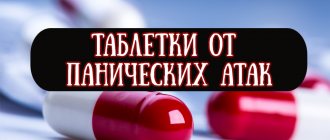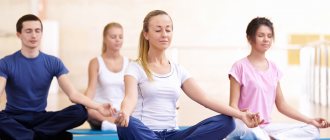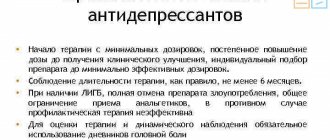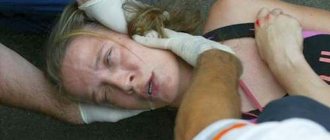If you need to quickly stop a panic attack, use simple but effective calming breathing. Just do it correctly so that breathing really helps cope with PA.
I have already written about calming breathing here and here. It is based on diaphragmatic breathing. But with some difference.
If when training normal diaphragmatic breathing (belly breathing) you pause while inhaling, then during an attack of PA you need to pause while exhaling. The breathing pattern is as follows:
Short active inhalation – Long relaxed exhalation – Pause
The inhalation and pause are approximately equal in time, but the exhalation should be 2–3 times longer.
Many of my readers and clients write that they are unable to calm their breathing, or that it does not help them cope with PA. And all because they do not fulfill a number of important conditions in order for this breathing to really work.
Breathing and vegetative-vascular dystonia
You have already been able to see that physical activity is one of the main therapeutic and preventive means for vegetative-vascular dystonia. However, it should be remembered that any medicine has its own contraindications. The same is typical for exercise therapy.
Professional sports are absolutely contraindicated. This type of activity involves constant extreme loads. Only a completely healthy body can withstand them without any harm to itself. This postulate also applies to any other occupations that involve heavy physical work.
However, you can engage in most sports at moderate levels, as determined by your doctor. There are only a limited number of activities that are completely contraindicated in VSD:
- crossfit (interval aerobic strength training)
- strength exercises are prohibited for any form of vegetative-vascular dystonia;
- deadlift;
- track and field events with pushing objects, jumping;
- long distance running
- sprint running;
- artistic gymnastics, acrobatics;
- martial arts.
The concept of vegetative-vascular dystonia implies a disruption of the autonomic system, in particular a disruption of the functioning of its central and peripheral parts.
The following types of vegetative-vascular dystonia are distinguished:
- Hypertensive type - a disorder associated with high blood pressure, the presence of tachycardia and discomfort in the heart;
- Hypotonic type - a disorder associated with low blood pressure, headache, weakness, dizziness;
- Mixed type - the most common type, includes symptoms of hypertensive and hypotonic types.
Exercises that will help improve the well-being of a person with VSD by normalizing breathing.
Exercise by Dr. Kurpatov
It is based on shortening the pause between inhalation and exhalation. According to the doctor, it is during this third phase that fear is formed, which provokes panic attacks.
- To overcome it, inhale for 5 seconds, then hold the air for the same amount of time, followed by exhalation, which lasts the same period of time.
- On the next cycle, the inhalation is again 5 seconds, but the pause is already 4, and the exhalation is 6.
- With each subsequent cycle, one second must be removed from the pause and added to the exhalation until a ratio of 5 to 10 is achieved.
Sound exercise
It helps normalize breathing and emotional state. Inhale for 7 seconds, and then exhale the same amount of air, pronouncing the sound “and”. This practice is akin to meditation and improves the functioning of the central nervous system.
“I” can be changed to other sounds: o, a, m, sh. This leads to overall strengthening of the body.
Exercise "flower"
Based on inhaling the aroma of an imaginary plant. First, inhale its scent as deeply as possible, and then speed up the pace. As a result, you need to increase the duration to 3 minutes.
You should not perform this exercise if you experience discomfort. In such cases, take a break. Don’t chase results, the main thing is to normalize the function of the central nervous system.
Symptoms of hyperventilation may occur due to increased oxygen supply to the blood. Therefore, it is with this exercise that you can independently evoke the signs of a panic attack and get to know them better.
Vegetative-vascular dystonia refers to diseases accompanied by sudden problems with air supply, attacks of suffocation, superficial shortness of breath and panic attacks. Exacerbation of the pathological process is provoked by stressful situations, excessive physical exertion, excessive physical activity, and increased anxiety.
Why psychotherapy for PA is more effective than medication treatment
Panic attacks are changes that occur directly in the human psyche. They, of course, also bring physiological changes and affect the normal functioning of the body’s functional systems, but! The seed of what is happening is in the head. This is why professionally structured psychotherapy for panic attacks is more effective than using medications. Even the most modern ones.
When choosing a psychotherapeutic path to cure panic attacks, the sufferer and the specialist have a greater range of options. There are not many medications, but there are about five hundred types and methods of psychotherapy. From such an abundance, it is easier to choose the most suitable method for a particular patient.
Psychotherapist panic attacks
Another argument is safety. Medications bring tangible relief and relieve frightening symptoms for a long time. They improve mood and create a positive emotional background. However, if we look at the contraindications, there are a lot of them: most medications are dangerous to take for a long period of time.
A psychotherapist works with a person’s consciousness, often without using any medications. The doctor feels for the underlying causes, identifies risk factors, finds the root of the problem - and pulls it out.
However, keep in mind: any psychotherapeutic intervention will give a good, lasting effect only if the person is amenable to this method of treatment. Otherwise, it is unlikely that you will achieve an impressive result.
Physical exercises for VSD
Doctors recommend performing such exercises in the morning and evening. It will be quite hard at first, but over time it will become a habit.
To begin with, you should choose a comfortable position in which the muscles will be as relaxed as possible. It is very important to do everything in order, as the tasks gradually become more difficult.
- We breathe evenly through our nostrils. We close our mouth. Try to learn to breathe evenly through one nostril (the other is closed with your finger). Once you have mastered this technique, you can begin jerky breathing movements. We breathe two - three times and exhale through our mouth. For the first time, it is enough to do five of these exercises. Over time, you can increase the number of breaths.
- Breathe through the abdominal cavity. We try to breathe so as not to move our chest. As soon as we inhale, we inflate our belly. Breathe with your nose. As we exhale, we pull our stomach in as much as possible. To perform tasks correctly, you can place your hands on your chest or stomach area. I repeat the exercises for him no more than twelve times.
- Let's breathe with our chest. We breathe so as not to move the front wall of the abdomen. As you inhale, we expand the area of the chest to the limit. We exhale dynamically, while compressing the chest area. Only the nose is involved in inhalation.
- Full breathing. If you mastered the first lessons perfectly, then try to master the fourth. As you inhale, we open the chest area to the maximum and push out the front wall of the abdomen. We exhale peacefully and draw in the abdominal walls. During this period, only the nose is involved in the breathing process.
All exercises are done with the same number of inhalations and exhalations.
During physical exercises for VSD, which serve as an auxiliary method of therapy, it is necessary to adhere to basic recommendations.
To strengthen the general health of a patient with VSD, a special set of physical exercises is individually selected for him, which can improve his well-being with vegetative-vascular dystonia.
With VSD, limited physical exercise is recommended for people with high blood pressure. Patients with VSD with a tendency to high blood pressure are advised to carry out exercise therapy that does not lead to overexertion. These include:
- Exercise in the morning, which has a strengthening effect on the body;
- Therapeutic gymnastics with breathing exercises;
- A set of relaxing physical exercises that help strengthen the heart and lungs.
Physical therapy for people with VSD must be carried out under medical supervision. After physical exercise with VSD, it is necessary to measure blood pressure in order to take into account what loads can be given to the body.
The patient learns to even out breathing and monitor the heart rate. If physical exercises with VSD begin to become very tiring and cause discomfort, then they are stopped for a while so that the body has the opportunity to rest.
What the effect of exercise therapy will be is directly related to how the patient does breathing exercises. They allow a person to learn to even out breathing and control it, which helps to maximize the enrichment of cells with oxygen. This is necessary for the proper functioning of the body and helps to cope with the disease. These exercises are indicated for patients with all types of VSD:
- Inhale and exhale through your nose without opening your mouth. First you need to inhale and exhale rhythmically 2-3 times. After this, you should breathe alternately through one and then the other nostril, closing one of them with your fingers.
- Use your abdominal muscles in this exercise while inhaling air through your nose. Inhale deeply, as if filling your stomach with air, then exhale sharply through your mouth, strongly draw in your stomach, tensing your abs.
- Do the same exercise, only using it not the stomach, but the chest.
- Slowly inhale through your nose, then exhale sharply through your mouth. After exhaling air, you should hold your breath for several seconds.
- Inhaling air through your nose, raise your arms, spread them in different directions, and bring them above your head. Exhale, lowering your arms along your body, and lightly shake your hands.
By doing at least 10 minutes of daily breathing exercises, a person can feel much better. The body will be actively saturated with the oxygen it needs for normal functioning.
You can successfully perform therapeutic physical exercises at home. It is useful to do physical exercises in the morning and evening, but training can be done at home at any time convenient for the patient. There is exercise that is recommended to be done daily, without various devices, in a familiar home environment.
What kind of physical exercises are these:
- Stand straight, lower your arms along your body, inhale deeply, extend your left arm in front of you, and extend your right arm back. Exhale and take the starting position. Do the exercises 10 times, changing hands in turn;
- Place your hands on your shoulders, place your feet shoulder-width apart, and straighten your back. Slowly roll your shoulders, remembering to breathe deeply;
- Bring your palms together at chest level, pressing them tightly together, bend your elbows. Hold for 10 seconds, then lower your hands down. Repeat the physical exercise at least 10 times;
- Place your feet shoulder-width apart and place your hands on your waist. Raise your left hand up, then extend it in front of you, making rotating movements with it. Repeat the same with your right hand. Do physical exercise 10 times;
- Tilt your head forward and slowly move it in turn in different directions;
- Stand up straight, put your hands on your waist, and take turns leaning forward and backward;
- Stretch your arms in front of you and make a movement with them, as if cutting with scissors;
- Lie on your stomach, stretch your arms forward. Raise your arms and legs at the same time, imagining a boat;
- Do a swallow while standing; to do this, move one leg back. Spread your arms out to the sides and lean forward. At the same time, try to raise your extended leg as high as possible;
- Lie on your back, performing rotational actions with your legs raised, pretending to ride a bicycle;
- Putting your hands on your waist while standing, bend in different directions, then perform pelvic rotation;
- Do push-ups on the floor at least 10 times;
- Do squats with your arms extended in front of you.
By performing a complex of exercise therapy every day, you can successfully fight all types of VSD. Regular physical exercise for VSD is the main weapon in the fight against the disease, since thanks to a set of exercises you can completely defeat this pathology.
Doing the right exercises is available to everyone. Here are some of them that will help you master breathing exercises for vegetative-vascular dystonia in the required volume.
It is better to do the breathing exercises suggested below for VSD in the position in which the patient feels most comfortable: he can stand, lie, sit on a chair or on the floor with his legs crossed or with his heels tucked under him.
An approximate set of exercises looks like this:
- At the very beginning of classes, you need to breathe as a person has always been used to. In this case, the mouth should be closed, and breathing should occur entirely through the nose. If you have enough breathing, you need to close one nostril with your finger and continue breathing through your nose, but at the same pace.
After a minute of such breathing, you need to change the nostril and hold for the same amount of time. When such actions are mastered, it is recommended to complicate them - inhalations should be carried out in bursts in several stages, and the air should be exhaled through the mouth. The exercise is repeated six times.
In order to develop abdominal breathing, the following exercise is shown. The patient holds the chest motionless, straining the lungs, while the stomach should be protruded. Breathing is carried out through the nose, but during inhalation the stomach should make vigorous movements. To understand whether the action was performed correctly, you can place your hands on your stomach or chest. The exercise must be repeated twelve times per technique.- Exercise for chest development. The abdominal muscles must be kept in a stationary position, but the chest must actively move - expand and contract. Repeat the exercise at least ten times.
- This exercise combines elements of the previous exercises. Both the lungs and the stomach are filled with air as much as possible. Exhalation is done while slowly drawing in the abdomen and squeezing the chest. It is best to place your hands on your chest and stomach. Repeat these steps up to ten times.
- If the patient feels an attack of dystonia, you can use the bag exercise. For these purposes, you should always have a small paper bag with you that is pressed tightly to your cheeks and nose. It is necessary to breathe into it with rhythmic breaths for several minutes until the attack stops.
Breathing exercises according to Kurpatov are a great way to get rid of attacks.
To do this, you need to inhale, hold your breath and exhale for five seconds. Then the time for inhalation is shortened by a second, but this second is added to the time of exhalation. The exercise is done ten times until the inhalation becomes sharp and lasts for one second, and the exhalation is prolonged to ten seconds. Usually by this time the attack has passed, so this exercise is considered very effective for attacks of dystonia.
Exercises for vegetative-vascular dystonia are recommended to be performed in various poses, which also creates additional training for the patient’s body. At the same time, such exercises should not be considered full-fledged substitutes for physical therapy - patients perform it separately.
If you do breathing exercises correctly and regularly, complementing treatment with other techniques, you can get rid of attacks of dystonia for a long time.
PA part 1. Self-treatment of panic attacks
Greetings to all those interested or suffering from panic attacks/PA and increased anxiety, my name is Andrey Botsulyak, in this note I will share my practical experience in the fight against this illness, which I have collected and applied over many years of my consultations since 2011.
What value will reading this article give you?
- You will learn how you can cope with PA on your own.
- You will understand the nature of panic attacks, find clear answers to the questions: what is it, why do they occur
- If you are a specialist, you may be interested in knowing what strategies can be used for effective therapy.
- If you suffer from them, by putting my recommendations into practice, you will be able to better control the onset of attacks and understand how to get rid of them forever
The first part of the material will be aimed at describing the process of PA and methods of relieving anxiety, and the second, at a detailed analysis of the underlying causes of their occurrence and treatment of the advanced phase, that is, the transition of a series of attacks into a chronic disorder.
- Causes of attacks
- Symptoms and causes of panic attacks
- How to get rid of PA yourself
- Step-by-step instruction
Three possible causes of panic disorder:
- Associated with some kind of physiological disorder, which is diagnosed with a full examination, perhaps this is the rarest case. Here, first of all, you need to work with the physiological disorder, and at the same time treat panic attacks, if there is such a need.
- When a healthy person once felt ill at the wrong time in the wrong place, and he, being susceptible, begins to experience anxiety in anticipation of the next similar incidents and artificially creates a panic disorder in himself. This is a rather uncommon situation, in which case the therapy is the simplest and shortest, it is described below in the article.
- The most common scenario for the development of attacks is associated with a primary irrational fear, which has very real reasons, fears that have long been repressed into the unconscious, and which have returned in the form of panic attacks in the present. It is impossible to treat this on your own; you can only learn to control and tolerate PA more calmly. More details about the causes and methods of getting rid of this form of panic disorder are written in the second part of the material “Panic Disorder Therapy”
What is a panic attack and what are its symptoms? I will not describe in detail what PA is, since the person who finds himself on this page already understands what he is faced with. This is a state of uncontrollable or poorly controlled fear/panic/horror, accompanied by the following symptoms:
Causes of panic attacks
There can be many reasons why a person could feel bad and start to panic, from being in a queue, or a stuffy closed room with strangers/alone, to something heard/seen/remembered that caused an association with the past, long forgotten frightening life episode. But the escalation of one attack into a whole disorder, with periodically repeating uncontrollable attacks, is already the result of self-inflation and fear of experiencing something like this again in the future, and probably the most important point is the formation of the habit of reacting with fear to the slightest deterioration in physical condition, which greatly increases even the weakest symptom . This picture illustrates everything very well
How to get rid of panic attacks yourself
This may surprise you, but almost every person has experienced a panic attack at least once in their life, just not everyone remembers it and does not attach much importance to it, since it was an isolated incident. Even without really straining, I can remember offhand several vivid situations in which I even lost consciousness for a split second, the interval between these attacks was several years and I didn’t see any problem in this, and probably a dozen more situations when I prevented them , although now I understand well that if I paid attention to the symptoms and began to stress myself out at moments of anxiety or deterioration in health, I would calmly train my psyche to react with attacks on my conditions and it would develop into a chronicle. Therefore, with regard to prevention, there is no need to dramatize and elevate each deterioration of the condition to the rank of a serious illness, with obligatory continuation, which is what most often happens. Now, let's move on to real practical recommendations for getting rid of panic attacks on your own:
- Medical examination
In order to make sure that there are no physiological reasons for the attacks and not to trigger some serious disease, just in case, get examined and make sure of your physical health; sometimes some physical problems serve as the trigger.
- Understanding the real causes of panic
If you decide to try self-treatment for panic attacks, or at least try to control them, it is important to understand what exactly causes anxiety, what you are most afraid of, what deep-seated fear is behind it. When the secret becomes apparent, it is easier for us to manage it. This can be done by asking yourself questions, as I do for a client in the audio recording given in the second part of the article >>
Questions:
- What's the worst that can happen?
- What am I afraid of?
- what happens after this?
- How will I feel as a result of this?
- What's scary about this for me?
- what could be the consequences of this?
There are a number of common deep-seated human fears, such as:
- of death
- for the lives of loved ones
- loneliness
- to be abandoned, etc.
When you understand what you are most afraid of, you will be able to relate it to the real threat and come to the logical understanding that there are no real reasons for concern, this will be the beginning of proper self-treatment of panic attacks.
- Changing your attitude towards the problem
Probably the most key point in preventing panic attacks is changing our perception of the problem, because the development of events directly depends on our assessment of the situation. It is important to understand the whole range of connections between our mental processes and external reality.
Example
You have already had your first attack and you are traveling on the subway in the summer, you are stuffy and lacking air, you can evaluate this in different ways and this will directly determine whether you will have another attack or not.
1st option. You remember your first attack and a thought arises, that is, an assessment of your condition, that I’m about to feel bad again and I can’t do anything, in response to the assessment, excitement arises, your adrenaline rushes and absolutely naturally your body enters combat mode readiness, because of this, your heartbeat quickens and you begin to panic, you lose your breath and you feel that a panic attack is about to happen, and it happens. Another quite natural effect is when you start breathing quickly, hyperventilation of the lungs occurs and dizziness begins. For the experiment, you can simply lie down and start breathing quickly, being in a normal state, there is an outflow of blood from the limbs, a lack of oxygen, numbness, and you can evaluate the condition as worsening, but in itself, without our negative assessment, this is simply a change in physiological processes By the way, the psychotherapeutic method of holotropic breathing was built on this principle.
2nd option of reaction to worsening condition. While in a stuffy subway car, you begin to breathe deeply and slowly, without dramatizing, without concentrating on natural symptoms in the body, without expecting things to get worse, but trying to calm your nervous system, reminding yourself that no one has ever died from panic attacks. Give your condition a more objective assessment. There is no reason to panic, just a little lack of oxygen or increased heart rate. Accept that it is normal to sometimes feel fear or negative feelings. As a result of accepting your condition and stabilizing your breathing, without aggravating stress with the anticipation of a complete loss of control over your body, you will gradually return to normal and a panic attack will not happen. Thus, the most important preventive tool for preventing PA is an objective assessment of the situation and acceptance.
Instructions
When you start to panic for no reason, or one of the physiological symptoms of PA appears, you need to:
- To clearly define a symptom, for example, rapid heartbeat or fear, having established it, there is no need to continue further unwinding of the development chain, that is, negative self-programming
- Start breathing slowly and deeply (with your stomach), holding your breath for a few seconds
- Accept your condition, literally say to yourself that it is quite natural to sometimes experience fear or a racing heart
- If any negative thoughts come, switch to constructiveness, accept your condition, symptoms and continue to breathe
- After all that has been done, you need to get away from the chaos in your head, which develops panic, and start counting breathing cycles, for example, inhale for 3 seconds - hold for 3 seconds. and exhale for 4 seconds. Continue the procedure until the heartbeat stabilizes and the condition returns to normal.
From what you can do on your own, these are probably all possible recommendations. Auxiliary supplements can also help to help your nervous system recover and cope better with stress, but I give such recommendations only individually based on the results of diagnosing your condition during consultations.
If, using the instructions, the strength of the attacks does not begin to weaken and the intervals between them do not increase, read the 2nd part of the material>>, the underlying causes of panic attacks are discussed in detail and the therapy procedure is described, using a real example. In addition, if your attack began a long time ago, most likely you have developed agoraphobia, which is also very difficult to cope with on your own.
With respect to your time and psyche Botsulyak Andrey
Benefits of exercise
Patients who perform breathing exercises during VSD normalize the functionality of the nervous system, improve overall well-being and improve blood circulation.
If you decide to do breathing exercises, you must first consult with your doctor, as there are a number of contraindications.
A set of breathing exercises
The practice of breathing exercises, which has become especially widespread in oriental medicine, confirms that special exercises increase the volume of oxygen in the blood, and therefore in the tissues. If you regularly do breathing exercises, attacks of vegetative-vascular dystonia will become a thing of the past and a person’s health will improve.
It is necessary to learn how to do the exercises correctly. As an axiom, you need to accept the fact that human breathing is an involuntary process, but the body can control it and direct it in the right direction.
For example, if you are under severe stress, you should start breathing correctly - this will stabilize the heart, calm the nerve cells, relieve tension in the autonomic vessels, and make the pulse uniform. Thus, a significant part of the symptoms of stress will be eliminated, thanks to the will of the person and proper breathing.
According to experts, a person uses only 10 percent of the capabilities of the brain and 20 percent of the capabilities of the lungs. Even those people whose vital lung capacity is small can exercise and significantly increase this indicator.
If necessary, in moments of extremes, a person uses about 50 percent of his respiratory system. So why not make it work to its fullest?
As a result of performing such exercises, a person can get rid of:
- systematic headaches;
- acceleration of heart rate;
- breathing problems;
- feeling of tightness in the chest.
To normalize breathing and bring maximum benefit to your body, you need to follow several rules. They will help a person skillfully manage his lungs and achieve high results. So, let's get acquainted with the basic rules for performing such exercises:
All respiratory acts should be as complete as possible. This means that in addition to the chest, the abdominal muscles should also be involved in the breathing process. The full cycle should be built in this way - a deep breath is taken, during which the chest is filled with air and expands to its maximum, and at this time the stomach, on the contrary, is drawn in. At the same time, the diaphragm relaxes as much as possible to increase the space for air-filled lungs.- The entire breathing process should be done through the nose. In this case, you need to exhale as much as possible, but also through your nose. The inhalation should be capacious, but short, but the exhalation is better to stretch and do without tension, as slowly and freely as possible.
When air passes through the nose, it is warmed and moistened, and is also freed from dust and small particles of dirt. If breathing is difficult, for example, during physical activity or at high temperatures, then you can use your mouth for breathing.
- Breathing during gymnastics should correspond to the movements that the person performs. It is best to inhale against the backdrop of raised arms, and exhale air while bending slightly or lowering your arms. In this case, as you inhale, the arms straighten away from the chest, and as you exhale, the arms close, moving towards the chest. If you are working with weights, then inhale while lifting, and lowering the weight while exhaling. This will significantly increase the body's potential.
Vegetovascular dystonia (VSD) is a pathology of the autonomic nervous system. It provokes an imbalance of the sympathetic and parasympathetic departments, disrupting the functioning of blood vessels and internal organs.
Breathing exercises for VSD help to cope with the manifestations of pathology. It saturates the blood with oxygen, improves blood circulation, and increases vitality. Blood pressure normalizes. Gymnastics promotes vigor, good mood, and the absence of spasms and panic attacks.
Techniques for treating panic attacks
In their professional activities, psychotherapists use various techniques to help overcome panic states. The most common ones are:
- classical hypnosis;
- body-oriented approach (BOP);
- eye movement desensitization and reprocessing (EMDR);
- Ericksonian hypnosis;
- esoteric techniques;
- acupuncture for panic attacks;
- family therapy.
The first four appointments are carried out in special rooms and are confirmed by official research. The next two are based on the views of alternative medicine. The latter requires a direct, in-depth analysis of the family relationships of the person suffering from PA. For ease of perception, we have combined all the techniques into a summary table.
| Name | Peculiarities | Effect |
| Medical technicians | ||
| Classic hypnosis | A short-term technique that produces results quickly. It is based on introducing the individual into a controlled trance, during which the specialist creates settings that help the patient overcome panic attacks. | Effective only with patients who are initially easily suggestible. |
| TOP | The main task of the specialist is to detect clamps on the body of a person suffering from PA. It is believed that all pain points are the consequences of experiences and psychological trauma that occurred in a person’s life. By teaching a person to relax, you can stop panic attacks. | Helps with experiences of acute grief, loss, and sleep disorders. |
| EMDR | It involves simulating the eye movements of a person in REM sleep. The theory states: in this way the patient activates internal restoration processes, defeating PA. | A subtle technique that only helps if the specialist is truly qualified and knows what to do. |
| Ericksonian hypnosis | Softer compared to classical hypnosis. During the session, the specialist identifies internal problems, possibly dating back to childhood, and helps resolve them, relieving the patient of panic attacks. Self-hypnosis training is expected. | Effective for most people, as it can put almost anyone into a trance, leading to the desired results |
| Alternative techniques | ||
| Esotericism in PA | Esotericists say: PA is the result of an overload of a person’s consciousness with negative energy. At a certain moment it bursts out, knocking the soul out of the body. The basis of treatment is to teach the person to become whole again. | An interesting approach based on the methods of various esotericists. It helps provided that the person believes in it. |
| Acupuncture for PA | Like reflexology, the technique is based on influencing certain points of the human body, which open access to different areas of the psyche. It is believed that acupuncture helps restore peace of mind and get rid of the consequences of past stress. | An effective method in combination with others. |
| Family therapy | ||
| Family therapy | PA is the result of incorrect, traumatic relationships within the patient’s family: lack of understanding or trust between members, improper upbringing, frequent scandals, negativity. The consequences are corrected, the current situation is leveled out. | The effect is good: the patient begins to feel confident, relationships with the outside world are harmonized. |
As any practicing psychotherapist will attest, panic attacks are complex, multifaceted conditions that cannot be treated in the same way. Each individual requires an individual approach so that the achieved positive result is maintained for a long time. But it is necessary to treat destructive conditions; for this, modern science has many options and possibilities.
For questions about psychotherapy, please contact here Medical center Komendantsky Prospekt (metro) “Family Doctor” is located in St. Petersburg. The reception is conducted by: associate professor, candidate of medical sciences, O. N. Kushnir and psychologist A. A Eremeeva.
General principles of physical therapy for VSD
Physical therapy for vegetative-vascular dystonia is a simple and effective method of eliminating the symptoms of the disease. When your body begins to receive the required amount of physical activity, the cardiovascular and nervous systems come into a state of balance: blood pressure and heart rate normalize, weakness and discomfort go away, and the emotional background changes for the better.
Types of exercise that are suitable for people with vegetative-vascular dystonia:
- fast walk;
- swimming;
- water aerobics;
- cycling;
- dancing;
- aerobics (without strength elements);
- exercise in the gym (with light weights);
- Tabata (with a small number of approaches);
- yoga.
When doing physical exercise to strengthen the cardiovascular system, you need to know when to stop. Exhausting workouts are unlikely to benefit an unprepared body. Exercise therapy for vegetative-vascular dystonia involves regular and non-straining exercise. Excessive physical activity can cause dizziness, headache and even fainting in a person with vegetative-vascular dystonia.
Don't forget about your daily morning exercises! Morning exercises are enough to do 15 minutes. It should leave you with a feeling of vigor, not fatigue. If your symptoms worsen after exercise, try reducing your load and consult your doctor.
It is advisable to start any activity with walking. During warm-up, do not make sudden movements, swing your arms and legs with a large amplitude. The intensity of the workout should increase gradually. At the end of the session, pay attention to restoring your breathing and relaxing.
It is not necessary to keep detailed records of blood pressure, pulse and the number of exercises performed. People with vegetative-vascular dystonia are prone to anxiety, so excessive self-control can have a bad effect on the state of the nervous system. Choose those types of sports activities that you like so that they do not bring you negative emotions.
How to learn to breathe correctly during VSD
The treatment therapy algorithm includes:
- breathing should be measured and rhythmic, without sudden transitions;
- primary training begins with a small number of repetitions and a minimum time of holding your breath, with a gradual increase;
- During the exercises, patients should not have any discomfort, sudden attacks of dizziness and sudden darkening of the eyes - such deviations are often recorded in this subgroup of patients in the first days of performing gymnastics;
- when negative symptoms develop, a mandatory break is taken, after which the training schedule is carried out at a slower pace;
- all movements carried out during the process must be as smooth as possible - sharp turns and tilts are prohibited;
- When performing the complex, it is forbidden to be distracted - concentration will reduce anxiety and calm the nervous system;
- the number of workouts varies from one to three times a day, a prerequisite is to perform the complex on an empty stomach;
- when inhaling, only the nose should participate in the process - during the process, additional purification and humidification of the incoming air occurs;
- Maximum ventilation of the pulmonary region is achieved by breathing with the stomach - using the abdominal muscles.
The harm of improper breathing
The brain controls breathing vegetatively, that is, under normal conditions a person does not think about inhaling or exhaling. However, there are often people with ANS disorders who try to practice all kinds of breathing exercises, but without success.
People are accustomed to the fact that deep and frequent breathing is beneficial. However, this statement is not entirely true.
The reason is a violation of the basic rules of breathing exercises. Let us remember that the composition of the air that enters the human body includes oxygen, carbon dioxide and nitrogen - the “ballast” component.
- When O2 enters the lungs, it immediately enters the blood and is distributed to organs and tissues.
- But hyperventilation (deep and frequent breathing) helps to “wash out” carbon dioxide from the blood plasma and intercellular fluid, which is also used by the body to maintain the normal functioning of the circulatory, nervous and other systems.
Therefore, it is important to breathe correctly.
The main symptoms of respiratory distress that accompany people with VSD:
- feeling of discomfort in the chest;
- “lump” in the esophagus;
- feeling of a sharp lack of air.
Auxiliary signs:
- headache;
- fluctuations in blood pressure;
- sleep rhythm disorders;
- emotional lability;
- arrhythmias, discomfort in the heart area.
By stabilizing breathing and regular exercise, the condition is normalized and the main symptoms of VSD are eliminated.
An incorrectly performed complex can provoke an attack of the disease and worsen the general condition. Negative signs of violation of the rules of breathing exercises are presented:
- insufficient oxygen supply;
- inability to take a full breath;
- feeling of a lump in the throat;
- compression in the chest area.
Relative signs of improper breathing are presented:
- painful sensations in the chest area;
- sudden dizziness;
- semi-fainting and short-term loss of consciousness;
- arrhythmic contractions of the heart muscle;
- accelerated heartbeat - tachycardia;
- night sleep disturbances;
- problems in the psycho-emotional sphere;
- deterioration of the blood circulation process in the body.
Self-help for panic attacks: thoughts and emotions
Recommendations regarding thoughts and emotions:
- switch thoughts using distracting actions;
- reconsider your attitude towards health and death;
- determine with what thought it all began and prove to yourself the absurdity of this thought;
- Convince yourself that you can live with panic disorder;
- meditate;
- keep a diary;
- read a prayer.
You may notice that some self-help methods involve the body, emotions, and thoughts. For example, meditation. Performing complex breathing techniques not only stimulates the parasympathetic part of the ANS, but also changes the gas composition of the blood and switches attention.
Changes in one area lead to changes in another. For example, thoughts-memories of a pleasant event evoke pleasant emotions.
Examples of therapeutic exercises
It is advisable to perform all exercises sitting on a chair or in an armchair, with support on the back, or sitting on your knees, with support on your heels, in the lotus position or lying on your back.
- “Breathing with sound”: take a deep breath for 7 seconds, while exhaling make the sound “and”. The sound should be as long as possible: “i-i-i-i-i-i.” This sound has a positive effect on brain function. Other sounds are useful for various organs: “o” - heart and blood vessels, “a” - blood circulation, “w”, “m” - strengthening the whole body, calming. When exhaling with an open mouth and sound, crying and sobbing may occur. You shouldn’t interfere with them: this frees the diaphragm, removes the muscle block, which has a positive effect on your emotional and physical state.
- “Stepped breathing”: exhale completely, then inhale, but not quickly, but gradually, with pauses of about 2 seconds. Then you need to exhale in the same “stepwise” manner; you can accompany the exhalation with the sound “hmm.” Effectively helps with weakness, apathy, lethargy.
- “Scent of a flower”: take a deep breath, imagining that you are inhaling the wonderful smell of a flower, trying to draw it into your nostrils as deeply as possible. Gradually speed up the pace. Exhalation is spontaneous. This exercise promotes mental self-regulation.
- “Blacksmith’s bellows”: sharply retract the stomach 30 times at an accelerated pace. In this case, air is released with a characteristic sound through the nose. You can also punch the air in time with your abdominal movements or do light, rhythmic jumps.
Exercise therapy for patients with a tendency to low blood pressure should include the use of physical exercises with intense loads. This helps strengthen muscles, helps tone them and prevents the development of depression.
Recommended physical exercises:
- Athletics, including jogging (jogging);
- Training on a strength simulator;
- Carrying out active games as physical exercises.
Exercise therapy for VSD, which has a tendency to hypotension, is able to strengthen the walls of blood vessels and activates the normal functioning of the cardiac and respiratory systems. With regular training, exercise therapy can have a beneficial effect on the body and reduce the development of symptoms.
For people with a mixed type of VSD, physical exercises are selected and prescribed individually, taking into account each specific case. This especially applies to patients who experience frequent changes in blood pressure.
What is breathing?
Breathing is a cyclical process that involves more than just the lungs. When inhaling and exhaling, the diaphragm, intercostal, pectoral, and abdominal muscles also work.
Let's imagine how the cycle begins with inhalation: expansion of the lungs, followed by filling of the chest, then the stomach, the anterior abdominal wall protrudes forward. Inhalation is followed by exhalation, during which the whole process occurs in the same sequence in reverse - only the air leaves the lungs.
Each new respiratory cycle provides the body with a new influx of oxygen. However, in addition to oxygen, the body always contains some amount of carbon dioxide. The proportions between the amounts of these substances directly affect the state of the body.
How to breathe correctly?
If your health worsens, as well as anxiety or stress, you need to pay attention to the way you breathe. It is very likely that breathing has become frequent, shallow, and intermittent.
In this case, the balance of oxygen and carbon dioxide undergoes changes. The first thing to do is take a few deep breaths.
If you breathe quickly and deeply, hold your breath for a second or two. During this time it is impossible to suffocate.
Then slowly inhale the air and exhale gradually.
It is recommended to try to breathe through your nose. Passing through the nasal passages, the inhaled air is moistened and warmed. Breathing through your mouth is more natural during increased physical activity - for example, while running.
Breathing changes as your body position changes. For example, when we lift a heavy object, we usually do it while inhaling. We inhale air when we stand up or stretch our whole body. If, on the contrary, you sit down or lie down, you exhale.
If, with insufficient inhalation, the body does not receive enough oxygen, the head becomes “heavy”, it is difficult to concentrate, the consciousness is slightly confused, and a feeling of lack of air is created. But if you don’t exhale enough, if you breathe deeply and quickly, the effect of hyperventilation occurs.
The level of carbon dioxide in the blood drops, which leads to vasoconstriction. Moreover, the blood vessels of the brain are the first to narrow.
The body reacts to this with slight dizziness, and tingling pain in the heart area is possible. Several short, shallow inhalations and exhalations that stabilize the ratio of oxygen and carbon dioxide in your blood help correct the situation.
Do I need to contact specialists?
We've looked at how to deal with panic attacks on your own at the most inopportune times. I would like to draw your attention to the fact that not all problems can be solved with just one word. Sometimes you have to use pharmaceutical drugs and drink herbs. For example, after a difficult emotional day, Melissa helps me. Some people save themselves by taking a shower and so on.
For panic attacks, self-help is more likely to be effective. But, unfortunately, this does not always happen...
Therefore, I ask you: if you see that the written techniques do not work, books do not help and steps to calm you down only irritate or worsen the situation, then rush to a specialist: a psychiatrist, psychologist, psychotherapist, neurologist.
A neurologist (neurologist), by the way, is not the last place here! Sometimes PA can occur due to functional or organic problems in the brain.
Hello everyone, friends. In touch Pavel Butor is the author of this blog. Now I will recommend a strong specialist, psychoanalyst, psychologist and researcher.
Sergey Litan helped me get out of a depressed state, get rid of internal fears and become happier. It will help you too if you want to ask for help.
Sergey wrote to me on July 13th. He introduced himself as an expert in the field of psychology and psychoanalysis. He asked me to advertise his services on the blog. He said that for 20 years he has been helping people overcome depression, internal fears, phobias, and panic attacks. After his help, people regain joy and meaning in life.
But, as you yourself know very well, there are many scammers on the Internet now. They offer their pseudo-services - if only people would pay money. And I have a strict rule - to advertise only benefits for readers. Therefore, I invited Sergei to communicate with me via video call. I wanted to check for myself whether it really helps or is it all nonsense. Sergei immediately agreed, and we agreed on 18:00 the next day.
My problem: it’s unclear where internal fear and anxiety comes from. Internal dialogue that prevents you from being in the moment “here and now” and makes you “fly in the clouds.” Incomprehensible “corrals” on trifles. Fatigue, apathy, sometimes it seems that there is no point in my actions. And all this comes from nowhere and completely drowns the resource state of the body. I’ve never had severe depression, but for a couple of days I lost contact with the world. How and why this happens, I could not understand. And most importantly, I didn’t know how to deal with it.
As agreed, we called via video link on VKontakte. To be honest, I had never communicated with specialists on such personal topics before, so I immediately felt a little uncomfortable. But after about 5 minutes the awkwardness went away - Sergei turned out to be a pleasant person. For some reason I immediately felt trust in him.
And we started talking... We talked for more than 2 hours. How much have I learned about myself, friends! It was very interesting to analyze specific situations from my life, why I felt those emotions at that moment, how I should have acted, etc. And it was even more interesting to try the techniques that Sergei gave me.
The work was done in 2 directions: from the psyche and from the body. We found out that I lack certain hormones and this directly affects my condition. Sergei gave me a specific diet. I wrote everything down in a notebook and immediately after the consultation I ran to the store to get the necessary products.
From the mental side, we sorted out a lot of things. Childhood traumas, my basic fears, my personality type and what is typical for me, what not to do, etc. I simply really liked the 2 techniques that Sergey gave me: “How to improve your inner state in 5 minutes anywhere and at any time” and American technique “Liberation”, which helps to cope with negativity from the past.
A month has passed. I followed Sergei's recommendations, and it helped me. Every day I worked through 3 to 10 fears and situations from the past. Improved hormonal levels. I want to take a hormone test, but in general I feel much better. You know, there was awareness of what was happening to you. And the understanding that you control your emotions, and not the other way around. This is very cool!
I want to warn you right away. You'll have to work on yourself. Sergei will guide you in the right direction, and you will have to improve your life yourself. Understand this - there is no magic pill, but the help is very strong.
There were 2 things I liked most about working with Sergey:
- Individual approach. All recommendations will be just for you. No general concepts or psychological stuff. We are all different people. And what may work for one person and lift him out of depression, may kill another.
- Specifics. There are no vague recommendations. Everything is clear and to the point. Sergey is an expert, and you will immediately feel it.
A month has passed and I am very pleased with the result. Sergei’s methods really work, and that’s why I recommend his services to you.
You can contact Sergey Litan for help if:
- you have depression and it is caused by an understandable situation: the death of a loved one, loss of a job, no money, etc.;
- you have depression and it is caused by something unclear - everything seems to be there and everything is good in life, but there is no happiness and you don’t want to live;
- you are bothered by internal fears (as I was);
- panic attacks;
- I want to commit suicide;
- apathy;
- laziness;
- constant feelings of guilt and self-flagellation;
- you can’t concentrate on anything specific;
- feeling of hopelessness;
- a hopeless view of your future;
- feeling of loneliness, melancholy, etc.
Go to Sergey’s website and order the consultation you need. At the moment there are 7 types. You can communicate by phone or video call. You can also meet Sergei in person. Also on the site you can buy it separately for 95 rubles. you can buy the “Liberation” technique that I mentioned above.
And I wish you good luck, friends! Less negativity in life and more positive moments!
PS If you have problems, do not be afraid to contact specialists. There is nothing shameful in this - we are not ashamed to go to the doctor when we have a headache. So it is here: psychologists and psychoanalysts treat. They just treat something else.
Performing basic breathing exercises
The following simple exercises will help improve the well-being of a patient with vegetative-vascular dystonia:
- Rhythmic breathing through the nose. To complicate the task, try to release the air in jerks. You can also alternate nostrils when inhaling and exhaling.
- Abdominal breathing training. During inhalation, the chest should be motionless. Only the stomach works. The same should be done when exhaling. For convenience, place your hands on your chest and abs to control the correctness of the process.
- Chest breathing training. The principle is similar to the previous exercise. Now the stomach remains motionless while the chest is active.
- Full breath. It involves fairly deep inhalations and exhalations, using all the muscles of the chest and abdominals.
During a panic attack, breathe through a paper bag for a couple of minutes. This will allow you to calm down and normalize your well-being. The idea is to inhale the air you just exhaled with a high content of carbon dioxide. This eliminates the unpleasant symptoms of hyperoxia, such as dizziness, darkening of the eyes or numbness of the lips and fingers.
Online courses to combat panic and fears
I have good news for you: the problem of panic attacks is solvable and can be solved with “small losses”. There are good courses and webinars that will help you learn to control yourself during PA and control your emotions. I have made a selection of the 5 coolest courses. I think they will significantly speed up the process of defeating panic attacks.
№1. Brain Detox – 10 Lessons on How to Reboot Your Brain. Helps clear the mind and consciousness, reduce stress and anxiety - this helps reduce the intensity and number of panic attacks.
The author of the lessons is Viktor Shiryaev, an expert in developmental psychology and integral philosophy.
You can:
- better concentrate on your work;
- learn to notice new things around you;
- you will be able to control your attention;
- stop negative thoughts;
- prevent emotional stress in time.
Cost – 1,490 rubles.
№2. How to quickly cope with fear and anxiety - video lessons that last 1.5 hours. Cost – 800 rub. Often available at a discount.
What will you get as a result:
- learn to talk to the problem and thereby eliminate it;
- be able to turn negative into positive;
- try to adjust your visual, audio and kinesthetic channels to get rid of PA;
- you will be able to quickly eliminate panic attacks;
- You will be able to eliminate psychological trauma in your life.
The author of the course is the online school of creative thinking “Planerka”. It develops communication skills and creative abilities of a person.
№3. Master class 15 ways to get rid of fear - video lessons that describe practical techniques for getting rid of PA and fears. The cost of video material is 949 rubles.
What will he give you:
- practical techniques for relieving anxiety;
- learn to deal with fear and anxiety;
- you will feel peace and tranquility;
- learn practical ways to stop being afraid of the unknown;
- Find out what the causes of your fears and panic attacks lie.
The author is Alexander Zhurakovsky, an expert in working with fears, worries, phobias and panic attacks, a practicing psychologist.
№4. Video course First Aid Kit “Anti-Fear” – video lessons for overcoming sudden fear. The author of the course is Alexander Zhurakovsky.
What skills will you gain:
- learn to cope with emotions using simple techniques;
- learn methods to combat anxiety;
- try out the techniques of breathing restorative exercises;
- learn ways to get rid of fears;
- learn not to dwell on phobias.
Cost – 292 rubles.
№5. Video course How to get rid of fear once and for all? will help you gradually forget about fear and panic attacks.
The author of the video course is Denis Shvetsov, a practicing psychologist, psychotherapist, and expert in the development of stress resistance and positive mood.
Pros:
- you will know what you gain if you get rid of fear;
- get acquainted with the mistakes that cause fear;
- consider the causes of fear and panic attacks;
- learn the differences between the feeling of fear and the natural reaction to danger;
- and most importantly, you will discover how to get rid of the feeling of fear forever.
Cost – 990 rub.
Buteyko technique
Very often, patients with vegetative-vascular disorders are prescribed gymnastic exercises using the Buteyko method.
This is a very simple set of exercises for VSD; it should be performed on an empty stomach, three times a day.
You need to sit with a straight back, with your knees slightly bent, keeping your stomach and diaphragm relaxed.
First, a control sample is taken to determine the level of carbon dioxide in the body. To do this, you need to breathe evenly and calmly for a while, then hold your breath for 15 seconds. If there is a lot of carbon dioxide, then the delay will pass quite easily.
Then a weak, light breath is taken through the nose, while the stomach remains relaxed. Inhale for two seconds and exhale more slowly for 4 seconds. You need to breathe like this for at least 5 minutes. Then perform a control test again and repeat the procedure 2-3 more times. In total it takes no more than 15-20 minutes.
For patients with VSD, it may be difficult to perform this exercise, since at first it can be difficult to ensure that the chest and abdomen remain motionless. But the result justifies the difficulties in mastering it: after just a few days, sleep normalizes, suffocation disappears, a runny nose goes away almost immediately, and after a month shortness of breath disappears.
However, this method is not particularly effective for patients who have mixed type vascular dystonia: panic attacks do not go away, and may even become more frequent. Therefore, it is necessary to combine gymnastics with eliminating the psychological causes of PA.
Breathing exercises according to Buteyko improves the condition of VSD, rhinitis, bronchitis and even bronchial asthma.
The main idea of the Buteyko technique is to correct the level of carbon dioxide in the blood to stabilize the functioning of the respiratory center. The second name for gymnastics is “life on exhalation.”
The traditional exercise consists of several stages:
- Sit up straight and relax.
- Take a small breath, and hold your breath halfway through the exhalation. The duration of the pause is 15-20 seconds.
- Inhale smoothly through your nose so that your chest and stomach are not involved but remain relaxed. The work of the lungs is as superficial as possible.
- Then breathe for 2 seconds per inhalation and 4 seconds per exhalation with a similar pause.
For beginners, we do not recommend taking a break between basic movements. The duration of the workout is 5 minutes.
Exercises of Tibetan monks
- The patient sits on a flat, hard surface and crosses his lower limbs. The back should be as straight as possible. The right nasal passage is blocked with the thumb of the right hand, and inhalation is made through the left. The breath hold is 16 seconds. The exercise is repeated in a mirror order. The total number of approaches is no more than four times.
- The patient remains in the above position, the upper limbs are placed on the knees, the head should be lowered. The patient inhales quickly through the nasal passages, while simultaneously throwing back the head. At the exit, the head is lowered again - with the chin pressed to the chest.
- The patient stands straight, arms are located on both sides of the body. After taking a deep breath, both hands must be raised and in this position, put their backs to each other. Continue upward movement with closed hands, hold your breath for a few seconds. After releasing one quarter of the air on exhalation, the upper limbs are separated at an angle of 120 degrees.
- The patient stands straight, spreading his legs to the width of his own shoulders. Hands extended forward, fists clenched tightly. Take a quick and deep breath through the nasal passages and maintain a gap. At the same time, you need to quickly and widely spread your arms to the sides and return them to their original position. The entire scheme is repeated at least three times. After exhaling, the arms are extended along the body and a short break is taken. After a short rest, the entire cycle is repeated - up to three approaches. Over time, the patient needs to increase the number of repetitions to 7 units.
Tibetan gymnastics
This set of exercises helps normalize breathing, stop an attack of suffocation, and calm the nerves during VSD. At the beginning of performing gymnastics, you may experience slight dizziness, which quickly passes.
First exercise: I.p. sitting on the floor with legs crossed, back straight. Close your right nostril with your thumb and inhale. Hold your breath for 16 seconds. Exhale freely through your mouth. Repeat the exercise on the left side. One approach – 4 exercises for each nostril.
The second exercise of Tibetan gymnastics for breathing: I.p. the same, but the hands are on the knees. Inhale through your nose, throwing your head back. As you exhale, press your chin to your chest. Perform 7 repetitions.
Third exercise: I.p. standing, arms along the body. Take a deep breath, raising your hands and cupping them back to back. Stretch upward, holding your breath. After exhaling some of the air, spread your arms 120 degrees. Then, on a full exhalation, return to I. p.











